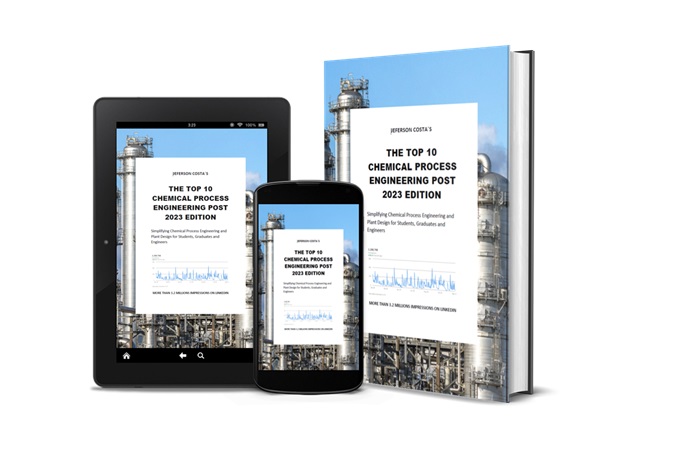Column Reboiler on Aspen Hysys
Heat exchange is one of the basic sets of knowledge you must have to work with chemical process engineering and plant design. Along with piping systems and rotating equipment, all process plant has some level of heat exchange.
Today, I will share with you an overview you should know about column reboilers. Moreover, you will learn which are the column reboiler pre-configurations available on Aspen Hysys.
To perform reboiler design and meet the process requirements and provide stable and flexible column operations, chemical process engineers must evaluate the physical, thermodynamics, and transport properties of fluids, define heat medium, heat duty, liquid levels, fluid temperature etc.
Reboiler design includes process specification, piping arrangement, thermal design, and hydraulic balance.
Column Reboiler Review
Reboilers are heat exchangers equipment responsible for generating vapor in a distillation process. Although it can be built of different manners, the shell and tube heat exchanger is the most applied in the industry.
As heat exchangers, the same principles for the material of construction can be applied to reboilers. Mild steel alloys have excellent heat-transfer coefficients and long service life. Copper alloys are not generally recommended due to process compatibility concerns. Stainless steel tube bundles can be used to reduce the possibility of tube failure from corrosion.
Classification
Depending on fluid circulation and reboiler position, reboilers can receive different classifications like kettle, thermosyphon, forced-circulation.
Kettle reboilers
Pool boiling is a typical characteristic of kettle reboilers. It is recommended to keep the vaporization rate at 80% boil-up to minimize excessive fouling.
Typically, liquid from the bottom of the tower flows through the shell side. The reboiler construction may include a wier (retaining wall) to keep the liquid level over the tube bundle to assure maximum heat transfer efficiency and to avoid tube expose by extreme heat that may result in dry out and tube damage. The heat medium flows through the tube bundle and exits as condensate.
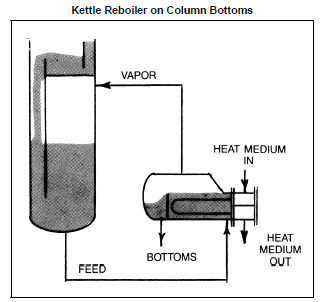
Thermosyphon reboilers
Thermosyphon reboilers can be horizontal or vertical, can be once-through or recirculating in operations depending on process design and available plot area.
The fraction vaporized for new equipment shall not be designed to exceed 30% for vertical and 40% for horizontal thermosyphon reboilers. The objective is to control the bottom’s flow rate through the thermosyphon and vaporization rate. In general, higher vaporization results in a lower heat transfer coefficient due to lower vapor heat transfer rate.
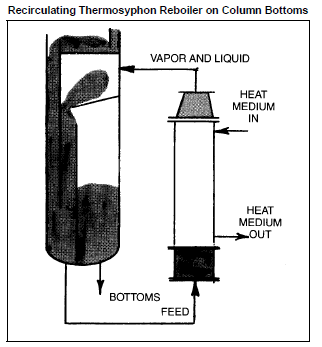
The once-through type thermosyphon reboiler withdraws liquid from the trap out pan, and the two-phase flow returns to the space below the trap out tray. Liquid head is constant during normal operation. Thus, the circulation rate is maintained constant. Percent vapor returned to the tower stays constant is the heat input is kept unchanged. The once-through reboiler is considered as one equilibrium stage for the distillation column.

Forced-circulation reboilers
These reboilers use a pump to force the liquid through the exchanger. It normally allows a 3 to 5 psi pressure drop or higher. They can be either vertical or horizontal with one or multi-pass construction. The main process characteristic of a forced reboiler is the low percentage of vaporization with high liquid circulation. Forced circulation is used especially when the viscosity of the liquid is higher than 2 cp.
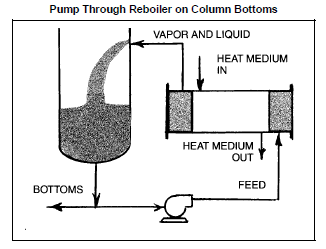
Reboiler flow chart selection
Start reboiler design and selection from scratch can be a hard task. Below, I share with you some references for a good starting point for your design.
Gas Processors Suppliers Association (GPSA) Engineering Data Book, in its Section 9 – Heat Exchangers, shows a reboiler selection chart from HTRI. In this chart, it is possible to select reboiler based on fouling fluid characteristic, pressure, viscosity and area required.

A more complex reboiler chart, shown below, can be found in the Ludwig’s Applied Process Design for Chemical and Petrochemical Plants, Volume III. This chart considers fluid characteristcs and process conditions.

Another reference for reboiler selection is available at Stanley M. Walas, Chemical Process Equipment: Design and Selection book. In this chart, user has a guide to reboiler selection based on best aplication to operating pressure, design delta temperature, fouling and mixture boiling range.
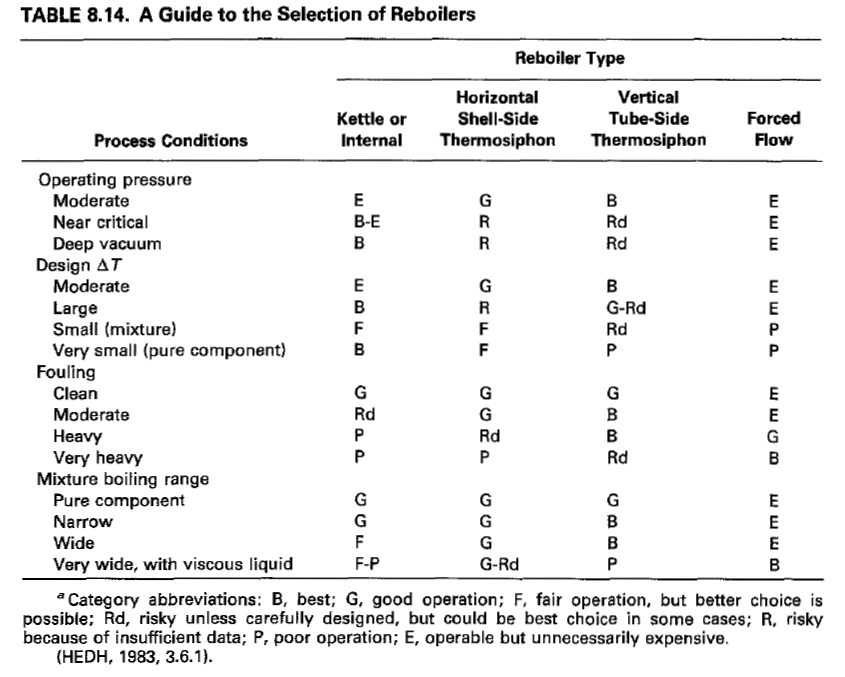
Aspen Hysys Reboiler Pre-configuration
Reboiler can be simulated as stand alone equipments on Aspen Hysys, but most often are associated to the configuration of distilation column or absorber in the process simulation software. Detalined heat exchanger design can be done using Aspen Exchanger Design & Rating (EDR).
For the distillation column and the reboiled absorber, it is possible to select reboiler pre-configurations as once-through, circulation without baffles or circulation with baffle in the page 2 of the column configuration wizard. Depending on the configuration you can specify a HYSYS Reboiler, a Heater, or a heat exchanger model as the reboiler type.

Reboiler Once-through
This configuration is available when using the kettle reboiler. The liquid coming from the stage above the reboiler passes through the reboiler once and is returned to the bottom of the column as a mixture of liquid and vapor.
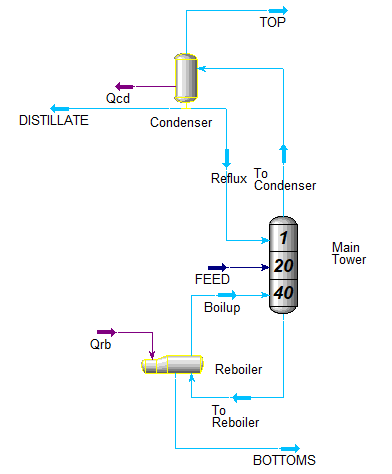
Reboiler Circulation Without Baffle
The liquid coming from the stage above the reboiler enters the sump, from which the bottoms and the reboiler feed are both drawn (with the same composition). The reboiler product is returned above the sump. Vapor may also be produced when the hot liquid return from the reboiler contacts the liquid in the sump.
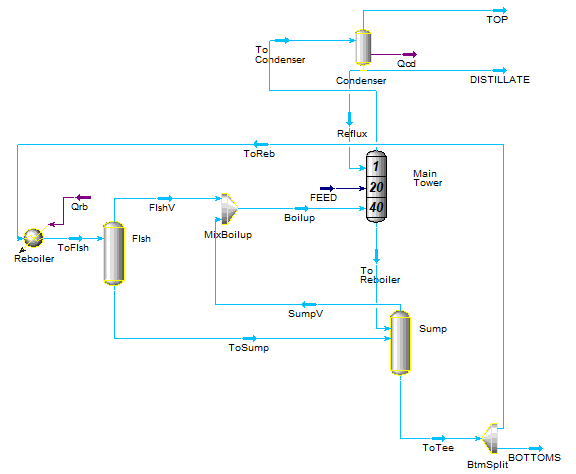
Reboiler Circulation With Baffle
The sump is divided into two sections with different compositions. The liquid from above the reboiler enters one section, from which the reboiler feed is drawn. The reboiler liquid product enters the other section, from which the bottoms stream is drawn.
Excess reboiler liquid return (above the flow rate of the bottoms stream) overflows into the first section. Vapor from the first section (along with that from the reboiler product) passes up to the stage above.
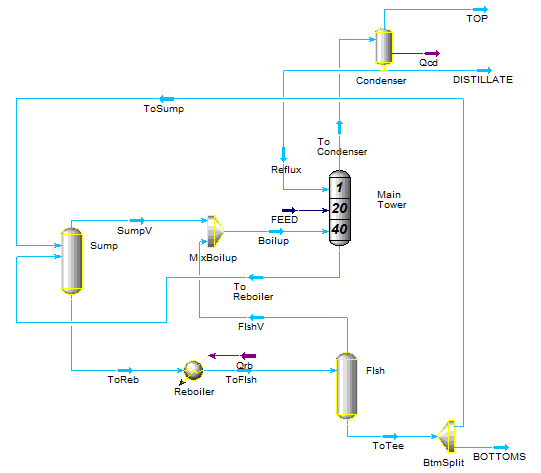
Reboilers types: advantages and desadvantages
Many sources talk about the advantages and desadvantages of different reboiler types. Below you find a table summary available in the Ludwig’s Applied Process Design for Chemical and Petrochemical Plants, Volume III. This summary table was published by Edward Chen in the Hydrocarbon Processing (HP) Magazine also.
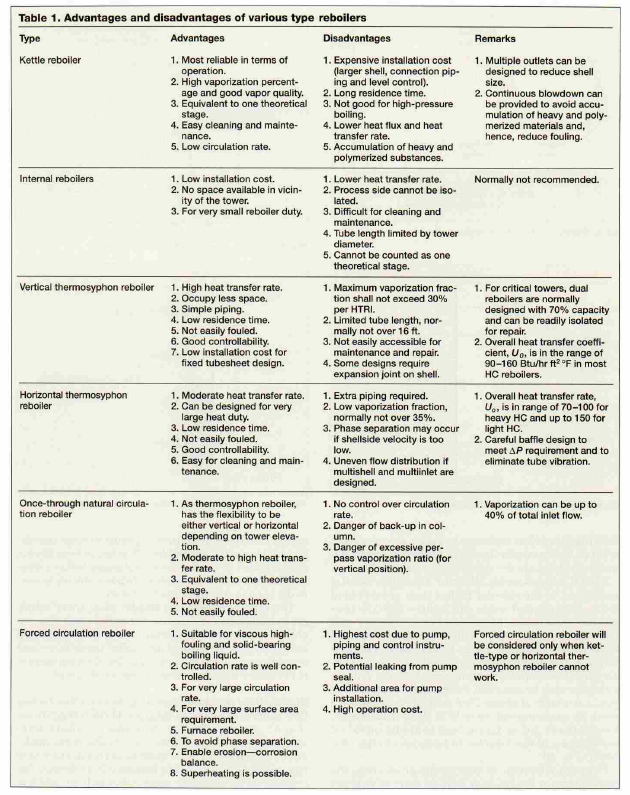
Chemical Process Engineering and Plant Design
Your roles and responsability as chemical process engineer in plant design includes the development of heat and material balance, in many cases, using process simulatin software like Aspen Hysys. However, process simulation by itself is not enough to install an equipment in the field. From the process simulation results the chemical process engineer must fill process and specification datasheet with enought information to equipment quotation by vendor or reboiler manufactures. These process information are required for the development of mechanical drawing for fabrication. After purchase and installation, you will use process simulation results to evaluate equipment performance.
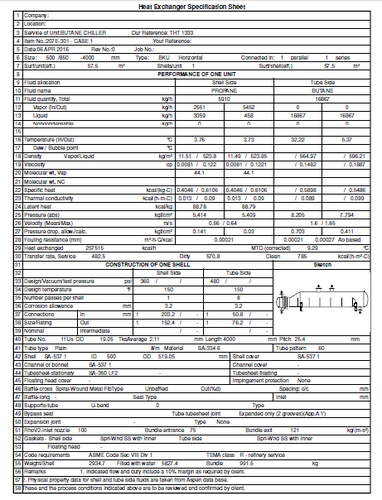

It is very important you keep improving your knowledge, not only about the fundamentals and process simulation but also about what Design Companies really want from you. Most of these answers, you will find following my social media and courses.
References:
- Gas Processors Suppliers Association (GPSA) Engineering Data Book.
- Ludwig’s Applied Process Design for Chemical and Petrochemical Plants, Volume III.
- Stanley M. Walas, Chemical Process Equipment: Design and Selection.
- How to select the best reboiler for your processing operation. HP Magazine.
- Optimize reboiler design. HP Magazine.
- Aspentech Aspen Hysys.
- Indiamart website.


